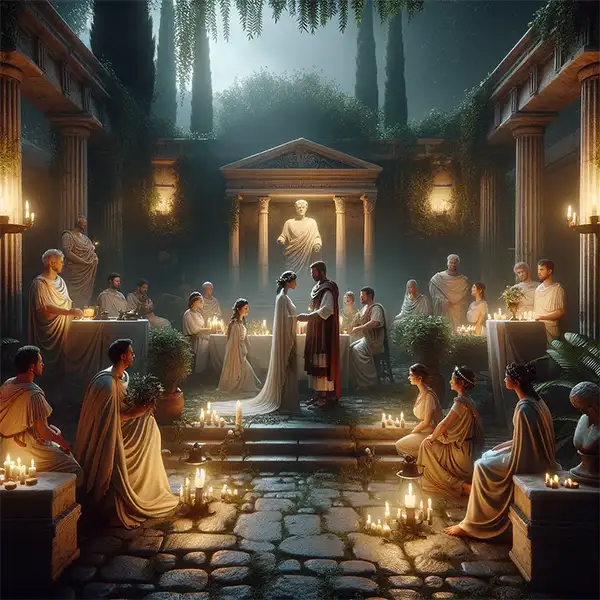Valentine's Day, oh, Valentine's Day! It is that special time of year when love is in the air, florists work overtime, and chocolate companies make a killing. It's the day when singles are reminded of their solitary status by every shop window, and couples feel the pressure to out-romance each other in a battle royale of affection. But where did this festival of love originate, and how did it become the global phenomenon it is today? Let's dive into the heart of the matter with a mix of facts and a sprinkle of humor.

A Tale of Saints, Sacrifices, and Secret Marriages
The tale of Valentine's Day is a saga that spans centuries, cultures, and even a bit of divine intervention. It's a story that takes us from the raucous streets of ancient Rome to the hushed whispers of clandestine lovers, all in the name of love.
Ancient Beginnings: Our journey begins in ancient Rome with the festival of Lupercalia. Celebrated from February 13th to 15th, this was not your typical Hallmark holiday. Imagine a city buzzing with energy, its citizens ready to partake in a tradition that was equal parts fertility rite and matchmaking lottery. Young men, clad in the skins of sacrificed animals, would run through the streets, gently slapping women with strips of hide. Far from being an ancient form of street harassment, this was believed to promote fertility, a vital concern in a world where the survival of your lineage was paramount.
Enter St. Valentine(s): As Rome transitioned from paganism to Christianity, the Church sought to replace pagan rituals with more wholesome Christian celebrations. Enter St. Valentine, or rather, the St. Valentines. History speaks of at least three different Valentines, all martyred and all somewhat connected to the themes of love and marriage.
 One popular story tells of a Valentine who was a priest in Rome during the reign of Emperor Claudius II. The emperor, believing that single men made better soldiers than those with wives and families, outlawed marriage for young men. Valentine, seeing the injustice in this, defied Claudius and continued to perform marriages for young lovers in secret. Unfortunately for Valentine, his defiance did not sit well with the emperor, leading to his imprisonment and his execution.
One popular story tells of a Valentine who was a priest in Rome during the reign of Emperor Claudius II. The emperor, believing that single men made better soldiers than those with wives and families, outlawed marriage for young men. Valentine, seeing the injustice in this, defied Claudius and continued to perform marriages for young lovers in secret. Unfortunately for Valentine, his defiance did not sit well with the emperor, leading to his imprisonment and his execution.
But Valentine's legacy didn't end with his death. Legend has it that while imprisoned, he healed the jailer's blind daughter, and before his execution, he wrote her a letter signed, "Your Valentine." This act of love and farewell is said to be the origin of the Valentine's Day card tradition.
From Pagan Rites to Christian Rights: With the end of Lupercalia and the rise of Valentine's Day, the Church succeeded in Christianizing a pagan festival. February 14th was officially declared St. Valentine's Day by Pope Gelasius I in the 5th century. However, it wasn't until the Middle Ages that the day became irrevocably associated with love. By then, the notion that birds paired off to mate on February 14th had become popular, as noted by poets like Chaucer, further entwining Valentine's Day with romantic love.
As centuries passed, Valentine's Day evolved from a festival of fertility and martyrdom to a more genteel celebration of love and affection. The exchange of hand-written notes and tokens of love in the Middle Ages laid the groundwork for the modern Valentine's Day, with its cards, chocolates, and flowers. Yet, through all its transformations, the essence of Valentine's Day remains the same: a day to celebrate love in all its forms, from the romantic to the platonic to the self-affirming.
So, there you have it—the origin story of Valentine's Day, a tale as rich and varied as love itself. From the ancient streets of Rome to the modern-day exchange of heart-shaped candies, Valentine's Day continues to evolve, reminding us of the enduring power of love.
From Pagan Rites to Chocolate Mites
As Christianity spread, the church wasn't too keen on pagan rituals involving animal sacrifices and fertility rites. So, they did what any good marketing team would do: rebrand. Lupercalia was out, St. Valentine's Day was in, and the focus shifted from fertility to love and romance.
By the Middle Ages, Valentine's Day had become a day for expressing love, with Chaucer and Shakespeare romanticizing it in their works, spreading its popularity throughout Europe. Fast forward to the modern era, and we see the commercialization of Valentine's Day, with cards, chocolates, and flowers becoming the go-to symbols of affection.

While we're all familiar with the traditional Valentine's Day rituals, there are some lesser-known and downright quirky traditions around the world. For instance, in Wales, lovers exchange hand-carved wooden spoons, a tradition dating back to the 17th century. In Japan, it's the women who buy chocolates for the men on February 14th, with the men returning the favor on White Day, March 14th.
Then there's Finland, where Valentine's Day is more about celebrating friendship than romantic love. And let's not forget the singles, who have taken to celebrating "Singles Awareness Day" (S.A.D.) as a counter to the couple-centric festivities.
A Day of Love, Laughter, and Economic Stimulus
Valentine's Day is not just about love; it's a major economic stimulus. In the U.S. alone, billions are spent on gifts, dinners, and getaways. It's a boon for businesses, from florists to jewelers to restaurants, making it one of the busiest times of the year. Yet, amidst the commercial hustle and bustle, the essence of Valentine's Day remains the celebration of love and affection, be it romantic, platonic, or self-love.
Whether you're a hopeless romantic, a cynic, or somewhere in between, Valentine's Day is a fixture on the calendar that's hard to ignore. It's a day that can be as much about grand gestures as it is about the simple, heartfelt ones. So, whether you're celebrating with a significant other or friends or indulging in some self-care, remember that at its core, Valentine's Day is a reminder to spread a little love and joy in the world. And who knows? Maybe getting slapped with an animal hide will make a comeback as the ultimate expression of love. But let's hope not.
Please Share our Content







 One popular story tells of a Valentine who was a priest in Rome during the reign of Emperor Claudius II. The emperor, believing that single men made better soldiers than those with wives and families, outlawed marriage for young men. Valentine, seeing the injustice in this, defied Claudius and continued to perform marriages for young lovers in secret. Unfortunately for Valentine, his defiance did not sit well with the emperor, leading to his imprisonment and his execution.
One popular story tells of a Valentine who was a priest in Rome during the reign of Emperor Claudius II. The emperor, believing that single men made better soldiers than those with wives and families, outlawed marriage for young men. Valentine, seeing the injustice in this, defied Claudius and continued to perform marriages for young lovers in secret. Unfortunately for Valentine, his defiance did not sit well with the emperor, leading to his imprisonment and his execution.









 "Sláinte!" is a traditional Irish expression used as a toast, equivalent to "Cheers!" in English.
"Sláinte!" is a traditional Irish expression used as a toast, equivalent to "Cheers!" in English.